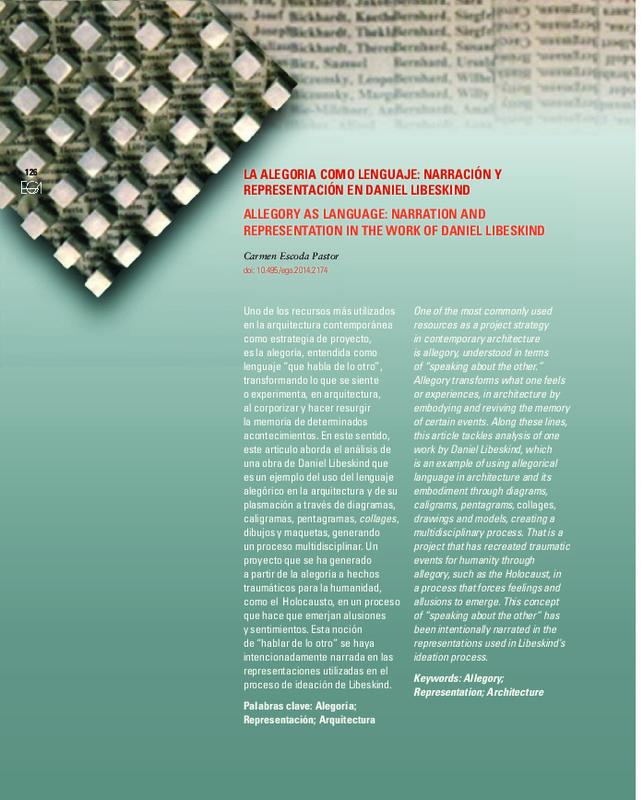JavaScript is disabled for your browser. Some features of this site may not work without it.
Buscar en RiuNet
Listar
Mi cuenta
Estadísticas
Ayuda RiuNet
Admin. UPV
La alegoría como lenguaje: narración y representación en Daniel Libeskind
Mostrar el registro sencillo del ítem
Ficheros en el ítem
| dc.contributor.author | Escoda Pastor, Carmen
|
es_ES |
| dc.date.accessioned | 2016-12-28T12:15:40Z | |
| dc.date.available | 2016-12-28T12:15:40Z | |
| dc.date.issued | 2014-05-15 | |
| dc.identifier.issn | 1133-6137 | |
| dc.identifier.uri | http://hdl.handle.net/10251/75869 | |
| dc.description.abstract | [EN] One of the most commonly used resources as a project strategy in contemporary architecture is allegory, understood in terms of “speaking about the other.” Allegory transforms what one feels or experiences, in architecture by embodying and reviving the memory of certain events. Along these lines, this article tackles analysis of one work by Daniel Libeskind, which is an example of using allegorical language in architecture and its embodiment through diagrams, caligrams, pentagrams, collages, drawings and models, creating a multidisciplinary process. That is a project that has recreated traumatic events for humanity through allegory, such as the Holocaust, in a process that forces feelings and allusions to emerge. This concept of “speaking about the other” has been intentionally narrated in the representations used in Libeskind’s ideation process | es_ES |
| dc.description.abstract | [ES] Uno de los recursos más utilizados en la arquitectura contemporánea como estrategia de proyecto, es la alegoría, entendida como lenguaje “que habla de lo otro”, transformando lo que se siente o experimenta, en arquitectura, al corporizar y hacer resurgirla memoria de determinados acontecimientos. En este sentido, este artículo aborda el análisis de una obra de Daniel Libeskind que es un ejemplo del uso del lenguaje alegórico en la arquitectura y de su plasmación a través de diagramas, caligramas, pentagramas, collages, dibujos y maquetas, generando un proceso multidisciplinar. Un proyecto que se ha generado a partir de la alegoría a hechos traumáticos para la humanidad, como el Holocausto, en un proceso que hace que emerjan alusiones y sentimientos. Esta noción de “hablar de lo otro” se haya intencionadamente narrada en las representaciones utilizadas en el proceso de ideación de Libeskind | es_ES |
| dc.language | Español | es_ES |
| dc.language | Inglés | es_ES |
| dc.publisher | Universitat Politècnica de València | |
| dc.relation.ispartof | EGA. Revista de Expresión Gráfica Arquitectónica | |
| dc.rights | Reserva de todos los derechos | es_ES |
| dc.subject | Allegory | es_ES |
| dc.subject | Representation | es_ES |
| dc.subject | Architecture | es_ES |
| dc.subject | Alegoría | es_ES |
| dc.subject | Arquitectura | es_ES |
| dc.subject | Daniel Libeskind | es_ES |
| dc.title | La alegoría como lenguaje: narración y representación en Daniel Libeskind | es_ES |
| dc.title.alternative | ALLEGORY AS LANGUAGE: NARRATION AND REPRESENTATION IN THE WORK OF DANIEL LIBESKIND | es_ES |
| dc.type | Artículo | es_ES |
| dc.date.updated | 2016-12-23T13:27:02Z | |
| dc.identifier.doi | 10.4995/ega.2014.2174 | |
| dc.rights.accessRights | Abierto | es_ES |
| dc.description.bibliographicCitation | Escoda Pastor, C. (2014). La alegoría como lenguaje: narración y representación en Daniel Libeskind. EGA. Revista de Expresión Gráfica Arquitectónica. 19(23):126-137. https://doi.org/10.4995/ega.2014.2174 | es_ES |
| dc.description.accrualMethod | SWORD | es_ES |
| dc.relation.publisherversion | https://doi.org/10.4995/ega.2014.2174 | es_ES |
| dc.description.upvformatpinicio | 126 | es_ES |
| dc.description.upvformatpfin | 137 | es_ES |
| dc.type.version | info:eu-repo/semantics/publishedVersion | es_ES |
| dc.description.volume | 19 | |
| dc.description.issue | 23 | |
| dc.identifier.eissn | 2254-6103 |








